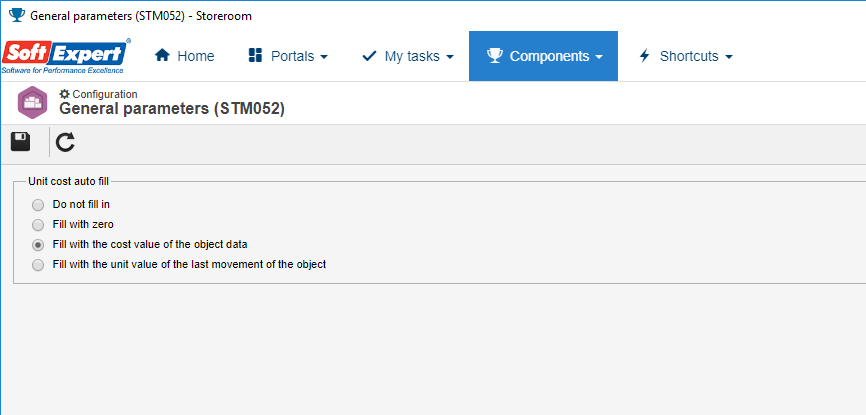
The system version update will perform a data conversion of the SE Storeroom component. The process is transparent, but the cost information will be migrated to a new table. Bear in mind this status when performing the version update.
Understand what has changed regarding the costs of the storeroom:
Where has changed and what's the impact?
The change was performed in the view stocks of the SE Storeroom component, impacting the unit cost values of the storeroom objects, the Analytics of this view, and the integration with Calibration, Maintenance, and Verification activities.
The system performed the calculation each time a survey was carried out on the stock view screen, it was necessary to check all the existing events to then present the cost. In addition, the cost value was also affected by the output events, which stopped occurring.
Why has it changed?
With the change, the information is already saved in the database, which improves the response performance for the view. In addition, the cost information per storage place was also added, allowing a better stratification of the result.
This structure will also serve as a support to allow new cost-associated functionality to be added to the system in the future.
How is the calculation performed?
The cost is calculated through the pondered average and the output events do not impact on the unit cost value. That is, the unit value of the object will be affected whenever a new input event exists.
Example 1:
Assuming the existence of two input events in one place/storeroom
▪50 units at $80.00/unit, totaling $4,000.00
▪25 units at $100.00/unit, totaling $2,500.00
The total earned value of the 75 units is $6,500.00 and a unit cost of:
$6,500.00 |
= $86.67/unit |
75 units |
When making a new input in the same place
▪50 units at $110.00/unit, totaling $5,500.00
The formula for the new unit cost is as follows:
Valuetotal.of.stock + Valuetotal.of.input |
Quantitystock + Quantityinput |
Replacing the values, we have:
75 units × $86.67 + 50 units × $110.00 |
= |
$6,500.00 + $5,500.00 |
= $96.00/unit |
75 units + 50 units |
125 units |
When making an output in the same location
▪Output of 25 units for maintenance activity
The cost for maintenance activity will be $2,400.00.
25 units × $96.00unit.cost = $2,400.00 |
The system will carry out the low stock of 25 units, but the cost of the unit value will not be affected.
The cost value may vary for the same quantity, from the same input taken from the same place between the programming and the execution of the activity, as there may be input events in that range.
When making a new input in the same place
▪10 units at $100.00/unit, totaling $1,00.00
100 units × $96.00 + 10 units × $100.00 |
= |
$9,600.00 + $1,000.00 |
= $96.36/unit |
100 units + 10 units |
110 units |
Example 2:
Input |
Output |
Balance |
|||||||
Date |
Qty. |
Vl. Unit ($) |
Vl. total ($) |
Qty. |
Vl. Unit ($) |
Vl. total ($) |
Qty. |
Vl. Unit ($) |
Vl. Total ($) |
05/20/2018 |
10 |
15.50 |
155.00 |
|
|
|
10 |
15.50 |
155.00 |
05/21/2018 |
8 |
17.50 |
140.00 |
|
|
|
18 |
16.38 |
294.84 |
05/21/2018 |
|
|
|
5 |
16.38 |
81.90 |
13 |
16.38 |
212.94 |
05/22/2018 |
6 |
16.10 |
96.60 |
|
|
|
19 |
16.29 |
309.51 |
What are the benefits?
▪Improved cost stratification by Storeroom and/or storage place;
▪The unit cost part is stored in the database allowing other types of analysis through Analytics;
▪When integrating with the SE Maintenance, SE Calibration, and SE Asset components, the costs of the maintenance/verification/calibration activities become more assertive with respect to the materials used in the activities. The modification allows the same input to be stored in different storerooms presenting separate costs depending on its location. For example, activities performed in different states, where the purchase value of the same input can be distinguished, impacting directly on the maintenance cost.
What must be configured?
For the calculation structure, there is no need to perform any configuration. However, because the unit cost information during input movement is the center point of the features, a general parameter has been created in the component for the user to define how he/she wants to fill that field. The configuration can be seen below:

The options identified are:
▪Do not fill in: it will end up forcing the user to always enter the information, because the unit cost field is mandatory;
▪Fill with zero: it fills the cost field with the zero value;
▪Fill with the cost value of the object data: it will bring the cost information that has been recorded in the object data (Supply, Item or Waste);
▪Fill with the unit value of the last object event: it will analyze the last input event performed for the Storeroom/storage place x object and fill with this value.
